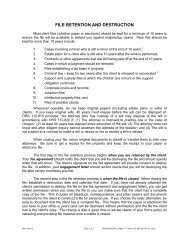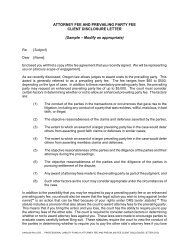ABA Model Guidelines for the Utilization of Paralegal Services
ABA Model Guidelines for the Utilization of Paralegal Services
ABA Model Guidelines for the Utilization of Paralegal Services
- No tags were found...
Create successful ePaper yourself
Turn your PDF publications into a flip-book with our unique Google optimized e-Paper software.
disqualification if (1) <strong>the</strong> paralegal has not acquired material or confidential in<strong>for</strong>mation<br />
regarding <strong>the</strong> litigation, or (2) if <strong>the</strong> client <strong>of</strong> <strong>the</strong> <strong>for</strong>mer firm waives disqualification and approves<br />
<strong>the</strong> use <strong>of</strong> a screening device or ethical wall. Zimmerman, 19 P.3d at 822.<br />
O<strong>the</strong>r authorities, consistent with <strong>Model</strong> Rule 1.10(a), differentiate between lawyers and<br />
nonlawyers. In Stewart v. Bee Dee Neon & Signs, Inc., 751 So. 2d 196 (Fla. Dist. Ct. App.<br />
2000) <strong>the</strong> court disagreed with <strong>the</strong> Koulisis rule that paralegals should be held to <strong>the</strong> same<br />
conflicts analyses as lawyers when <strong>the</strong>y change law firms. In Stewart, a secretary moved from<br />
one law firm to <strong>the</strong> opposing firm in mid-litigation. While Florida would not permit lawyer<br />
screening to defeat disqualification under <strong>the</strong>se circumstance, <strong>the</strong> Stewart court emphasized<br />
that “it is important that non-lawyer employees have as much mobility in employment<br />
opportunity as possible” and that “any restrictions on <strong>the</strong> non-lawyer’s employment should be<br />
held to <strong>the</strong> minimum necessary to protect confidentiality <strong>of</strong> client in<strong>for</strong>mation.” Stewart, 751 So.<br />
2d at 203 (citing <strong>ABA</strong> In<strong>for</strong>mal Opinion 1526 (1988)). The analysis in Stewart requires <strong>the</strong> party<br />
moving <strong>for</strong> disqualification to prove that <strong>the</strong> nonlawyer actually has confidential in<strong>for</strong>mation, and<br />
that screening has not and can not be effectively implemented. Id. at 208. In Leibowitz v. The<br />
Eighth Judicial District Court <strong>of</strong> <strong>the</strong> State <strong>of</strong> Nevada, 79 P.3d 515 (2003), <strong>the</strong> Supreme Court <strong>of</strong><br />
Nevada overruled its earlier decision in Ciaffone v. District Court, 113 Nev. 1165, 945 P.2d 950<br />
(1997), which held that screening <strong>of</strong> nonlawyer employees would not prevent disqualification. In<br />
Leibowitz, <strong>the</strong> court held that when a firm identifies a conflict, it has an absolute duty to screen<br />
and to in<strong>for</strong>m <strong>the</strong> adversarial party about <strong>the</strong> hiring and <strong>the</strong> screening mechanisms. The Court<br />
emphasized that disqualification is required when confidential in<strong>for</strong>mation has been disclosed,<br />
when screening would be ineffective, or when <strong>the</strong> affected employee would be required to work<br />
on <strong>the</strong> case in question.<br />
Still o<strong>the</strong>r courts that approve screening <strong>for</strong> paralegals compare paralegals to <strong>for</strong>mer<br />
government lawyers who have nei<strong>the</strong>r a financial interest in <strong>the</strong> outcome <strong>of</strong> a particular<br />
litigation, nor <strong>the</strong> choice <strong>of</strong> which clients <strong>the</strong>y serve. Smart Industries Corp. v. Superior Court<br />
County <strong>of</strong> Yuma, 876 P.2d 1176, 1184 (Ariz. App. 1994) (“We believe that this reasoning <strong>for</strong><br />
treating government attorneys differently in <strong>the</strong> context <strong>of</strong> imputed disqualification applies<br />
equally to nonlawyer assistants . . .”); accord, Hayes v. Central States Orthopedic Specialists,<br />
Inc., 51 P.3d 562 (Okla. 2002); <strong>Model</strong> Rule 1.11(b) and (c).<br />
Comment 4 to <strong>Model</strong> Rule 1.10(a) states that <strong>the</strong> rule does not prohibit representation by<br />
o<strong>the</strong>rs in <strong>the</strong> law firm where <strong>the</strong> person prohibited from involvement in a matter is a paralegal.<br />
But, paralegals “ordinarily must be screened from any personal participation in <strong>the</strong> matter to<br />
avoid communication to o<strong>the</strong>rs in <strong>the</strong> firm <strong>of</strong> confidential in<strong>for</strong>mation that both <strong>the</strong> nonlawyers<br />
and <strong>the</strong> firm have a legal duty to protect.” Id.<br />
Because disqualification is such a drastic consequence <strong>for</strong> lawyers and <strong>the</strong>ir firms,<br />
lawyers must be especially attuned to controlling authority in <strong>the</strong> jurisdictions where <strong>the</strong>y<br />
practice. See generally, Steve Morris and Christina C. Stipp, Ethical Conflicts Facing Litigators,<br />
ALI SH009ALI-<strong>ABA</strong> 449, 500-502 (2002).<br />
To assist lawyers and <strong>the</strong>ir firms in discharging <strong>the</strong>ir pr<strong>of</strong>essional obligations under <strong>the</strong><br />
<strong>Model</strong> Rules, <strong>the</strong> NALA <strong>Guidelines</strong> requires paralegals “to take any and all steps necessary to<br />
prevent conflicts <strong>of</strong> interest and fully disclose such conflicts to <strong>the</strong> supervising attorney” and<br />
warns paralegals that any “failure to do so may jeopardize both <strong>the</strong> attorney’s representation<br />
and <strong>the</strong> case itself.” NALA, Comment to Guideline 1. NFPA <strong>Model</strong> Code <strong>of</strong> Pr<strong>of</strong>essional Ethics<br />
and Responsibility and <strong>Guidelines</strong> <strong>for</strong> En<strong>for</strong>cement, EC-1.6 requires paralegals to avoid<br />
conflicts <strong>of</strong> interest and to disclose any possible conflicts to <strong>the</strong> employer or client, as well as to<br />
<strong>the</strong> prospective employers or clients. NFPA, EC-1.6 (a)-(g).<br />
Page 11
















